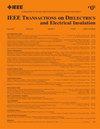Aging Failure Mechanism of Graft Modified Polypropylene Cable Insulation
IF 3.1
3区 工程技术
Q2 ENGINEERING, ELECTRICAL & ELECTRONIC
IEEE Transactions on Dielectrics and Electrical Insulation
Pub Date : 2025-02-18
DOI:10.1109/TDEI.2025.3543154
引用次数: 0
Abstract
The performance of polypropylene (PP) insulation material used in high-voltage power cables is crucial for ensuring the safe and reliable operation of the cables. To deeply understand the aging and failure mechanisms of graft-modified PP cable insulation, accelerated aging experiments were conducted on the cable insulation layer. The ac breakdown field strength and elongation at break were tested, the density functional theory calculations were performed on the graft-modified PP molecular chains, and further analyses of the physicochemical properties, such as the microstructure and molecular structure changes of the insulation material, were conducted. The results show that when the insulation material reaches the aging failure point, the breakdown performance significantly decreases, the perfection of the crystalline region structure of PP deteriorates with aging time, the content of C=O carbonyl groups significantly increases with aging time, and thermal-oxidative aging accelerates the destruction of PP spherulites. The appearance of oxidation products, structure loosening, and decreased crystallinity during the aging process are the main reasons for the reduction in mechanical performance and breakdown strength. This study provides new insights into the research on the aging mechanism, structure, and performance relationship of PP cable insulation and has important guiding significance for the design of PP insulation materials.接枝改性聚丙烯电缆绝缘老化失效机理研究
高压电力电缆中使用的聚丙烯(PP)绝缘材料的性能对保证电缆的安全可靠运行至关重要。为深入了解接枝改性PP电缆绝缘老化失效机理,对电缆绝缘层进行了加速老化实验。测试了交流击穿场强和断裂伸长率,对接枝改性PP分子链进行了密度泛函理论计算,并进一步分析了保温材料的微观结构和分子结构变化等理化性质。结果表明:当保温材料达到老化失效点时,击穿性能显著降低,PP晶区结构的完善性随老化时间的延长而恶化,C=O羰基含量随老化时间的延长而显著增加,热氧化老化加速了PP球晶的破坏。老化过程中氧化产物的出现、组织松动、结晶度降低是导致机械性能和击穿强度下降的主要原因。本研究为PP电缆绝缘老化机理、结构及性能关系的研究提供了新的见解,对PP绝缘材料的设计具有重要的指导意义。
本文章由计算机程序翻译,如有差异,请以英文原文为准。
求助全文
约1分钟内获得全文
求助全文
来源期刊
CiteScore
6.00
自引率
22.60%
发文量
309
审稿时长
5.2 months
期刊介绍:
Topics that are concerned with dielectric phenomena and measurements, with development and characterization of gaseous, vacuum, liquid and solid electrical insulating materials and systems; and with utilization of these materials in circuits and systems under condition of use.

 求助内容:
求助内容: 应助结果提醒方式:
应助结果提醒方式:


